The following is a summary of global temperature conditions in Berkeley Earth’s analysis of February 2024.
- Globally, February 2024 was the warmest February since records began in 1850.
- The previous record for warmest February was broken by 0.10 °C (0.18 °F), a moderate margin.
- The ocean-average also set new records for the warmest February.
- The land-average was the 3rd warmest observed, behind 2020 and 2016.
- Particularly warm conditions occurred in parts of South America, Eastern Europe, Central and Southern Africa, Central North America, large areas of the Atlantic, and parts of the Indian Ocean.
- Unusually cold conditions were present in part of Antarctica.
- 63 countries set new national monthly-average records for February.
- A strong El Niño continues but has weakened significantly, and is likely to end by mid-2024.
- 2024 is very likely to be either the warmest or second warmest year on record.
Global Summary
Globally, February 2024 was the warmest February since directly measured instrumental records began in 1850, breaking the record previously set in February 2016. This February exceeded the previous record by 0.10 °C (0.18 °F), a moderate margin.
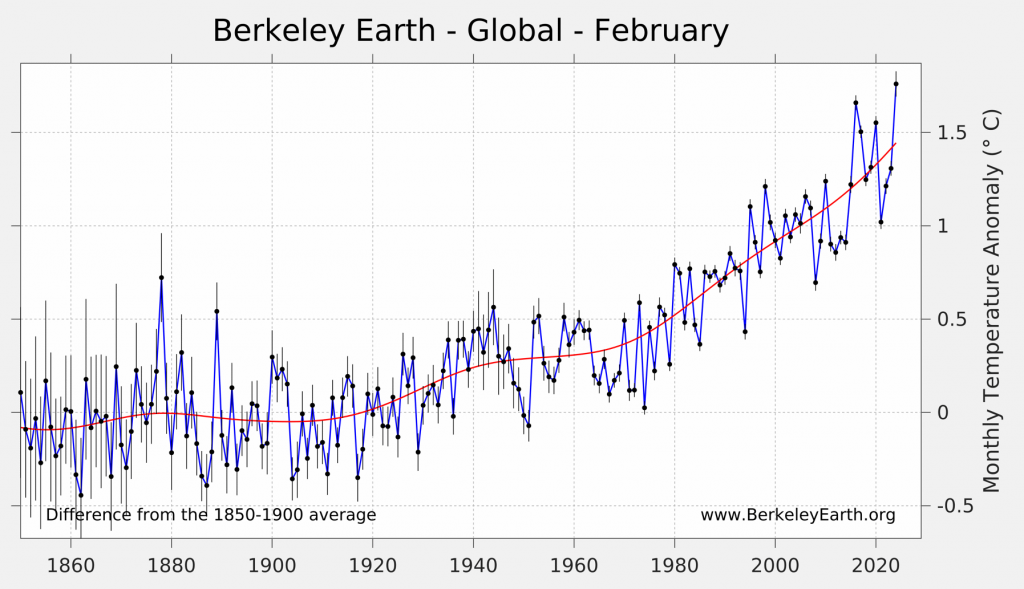
The global mean temperature in February 2024 was 1.76 ± 0.09 °C (3.17 ± 0.17 °F) above the 1850 to 1900 average, and the third largest monthly anomaly ever observed. However, it is somewhat cooler than in September of 2023.
February 2024 continues the run started in July 2023 of each individual month being at least 1.5 °C warmer than the 1850 to 1900 average.
One of the Paris Agreement ambitions has been to limit global warming to no more than 1.5 °C (2.7 °F) above the preindustrial baseline. That goal is defined in reference to the average climate over many years, so a few individual months or a single year above 1.5 °C do not automatically mean that the target has been exceeded. However, isolated anomalies above 1.5 °C are a sign that the Earth is getting close to that limit. It is likely that global warming will cause the long-term average to exceed 1.5 °C during the 2030s unless significant reductions in greenhouse gas emissions are achieved soon.
The last nine months have been extraordinary in terms of global average temperatures, with new monthly records being set every month and often by large margins.
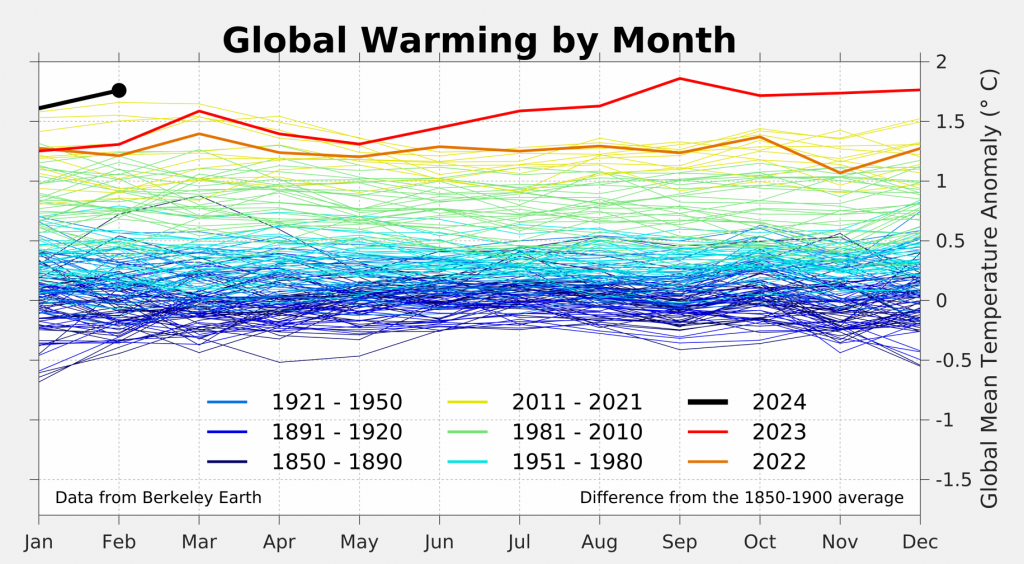
The global mean temperature anomaly in February 2024 noticeably increased relative to January 2024, but is similar to December of 2023. This remains well above the long-term trend line.

Spatial Variation
February 2024 continues the ongoing pattern of widespread warmth, with a few important exceptions. Particularly warm conditions were present in parts of South America, Eastern Europe, Central and Southern Africa, Central North America, large areas of the Atlantic, and parts of the Indian Ocean. Unusually cold conditions were present in part of Antarctica.
We estimate that 12.6% of the Earth’s surface experienced their locally warmest February average (including 10.7% of land areas), and 81% of the Earth’s surface was significantly warm when compared to their local average during the period 1951 to 1980. By contrast, 0.1% of the Earth’s surface had their locally coldest February.
The Equatorial Pacific in February continues to show strong El Niño conditions but has weakened significantly. An El Niño condition was officially declared by NOAA in early June 2023 and is expected to continue until mid-2024.

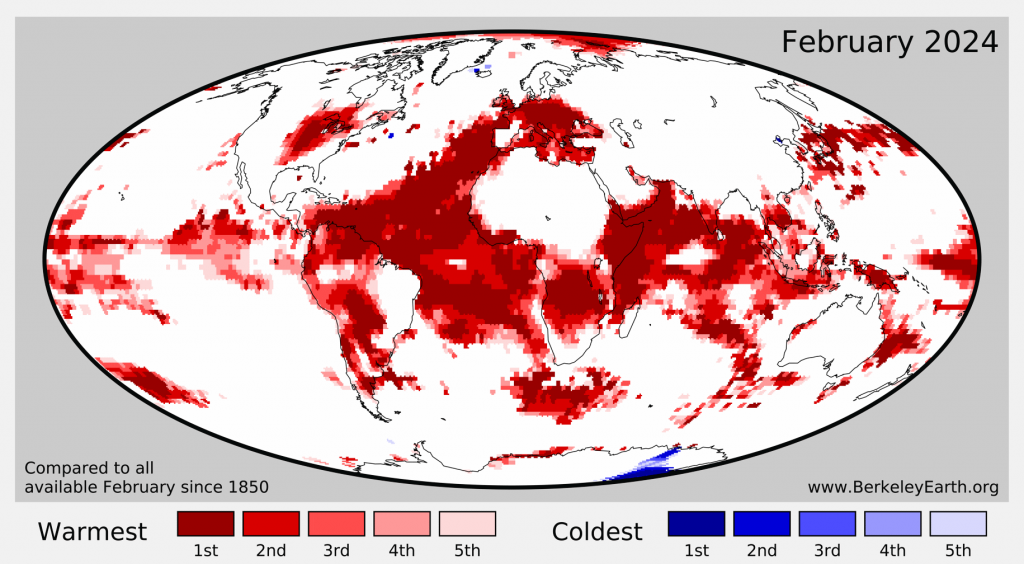
Over land regions, 2024 was the third warmest February ever observed. It was somewhat cooler than February 2020 or February 2016, but well above most other years. The land average was 2.42 ± 0.16 °C (4.36 ± 0.28 °F) above the 1850 to 1900 average.

In total, we estimate that 63 countries had their warmest national-average February on record, these were:
Angola, Antigua and Barbuda, Argentina, Austria, Barbados, Belgium, Bolivia, Bosnia and Herzegovina, Bulgaria, Cabo Verde, Cambodia, Chile, Croatia, Czechia, Djibouti, Dominica, Ecuador, Equatorial Guinea, Ethiopia, Gambia, Germany, Ghana, Grenada, Guinea, Guinea-Bissau, Guyana, Hungary, Italy, Ivory Coast, Kenya, Kiribati, Liberia, Liechtenstein, Luxembourg, Malawi, Moldova, Netherlands, Palau, Papua New Guinea, Paraguay, Poland, Romania, Saint Lucia, Saint Vincent and the Grenadines, San Marino, Serbia, Seychelles, Sierra Leone, Slovakia, Slovenia, Solomon Islands, Somalia, Suriname, Switzerland, Sao Tome and Principe, Togo, Trinidad and Tobago, Ukraine, United States, Uruguay, Venezuela, Yemen, and Zambia
February 2024 was the warmest February in the ocean average, recorded as 1.20 ± 0.11 °C (2.16 ± 0.19 °F) above the 1850 to 1900 average. This beats the previous record for February by a large margin.
The ocean temperature anomaly for February is modestly warmer than October, November, and December 2023, but still cooler than in July, August, and September 2023. It represents the fifth warmest monthly ocean temperature anomaly ever measured.
According to NOAA’s OISST, global ocean average temperatures have now set a daily temperature record every consecutive day for more than a year. This is due to the combination of El Niño and extremely unusual warmth in the Atlantic. This streak will likely end no later than the middle of 2024 as El Niño dissipates, bringing ocean temperatures below the highs of 2023.

Seasonal Variation: December to February
The December to February period (winter in the Northern hemisphere) was the warmest such period directly observed. Locally, this period was record warm in parts of South America, large regions of the Atlantic, parts of the Indian Ocean, central Canada, the Middle East, and parts of Eastern Europe. It was relatively mild in Northern Europe, and unusually cold in Central Antarctica.
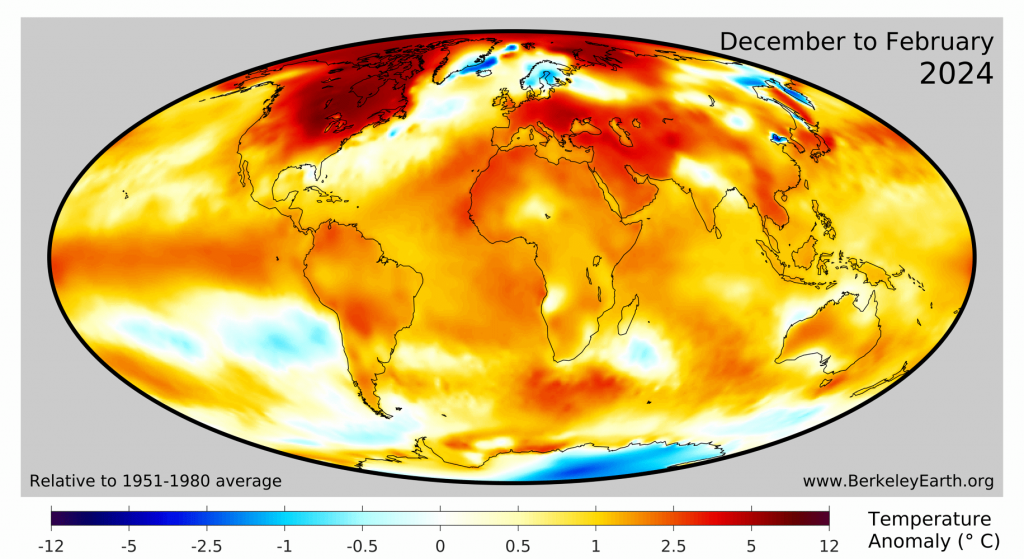
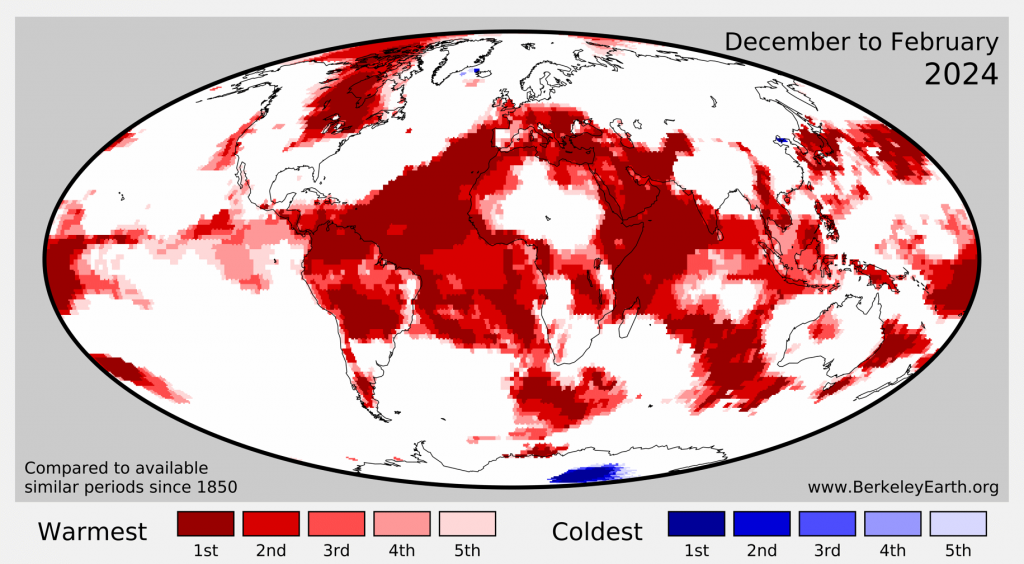
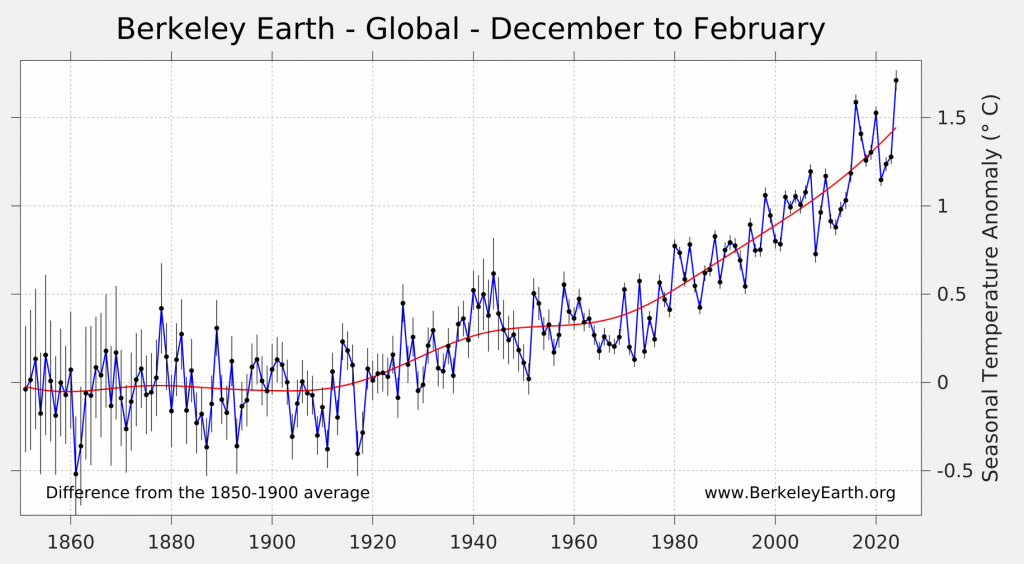
Causes of Recent Warmth
The record warmth over the last few months is due primarily to the ongoing El Niño condition in the Pacific, which is a form of natural variability associated with short-term swings in global temperature. This short-term change occurs alongside a background of longer-term man-made and other natural changes mostly also favoring warming during the present time.
Firstly, man-made global warming has been raising the Earth’s temperature by about 0.19 °C/decade (0.34 °F/decade). This is a direct consequence of the accumulation of additional greenhouse gases in the atmosphere, especially carbon dioxide. This is the primary factor responsible for long-term warming.
However, this global warming is a gradual process. It does not explain short-term spikes and fluctuations in Earth’s average temperature. The main reason for such spikes is internal variability in the distribution of heat and circulation of the oceans and atmosphere. The largest and most well-known form of short-term internal variability is the El Niño / La Niña cycle originating in the Pacific. During the El Niño phase, global average temperatures tend to be somewhat higher. As a result, record highs for global average temperature tend to be set during El Niño years. Last year, a new El Niño officially began in June after a multiple year period of La Niña. The rapid transition from a moderately strong La Niña to the current El Niño played a large role in the warming of 2023.
In addition to the natural El Niño variability, it is likely that other variability also contributed to recent extreme temperatures. One area of special interest is the Atlantic Ocean. The Northern Atlantic was persistently warm during the second half of 2023 and remains warm in February, with large regions continuing to set records. In recent month, significant warmth has expanded in the Southern Atlantic as well. If these change were entirely natural, the 2023 warming spike in the North Atlantic would be very rare. However, in a previous discussion, we noted that warm anomalies in the Atlantic are likely to be combination of natural variability and man-made regional warming due to new marine shipping regulations that abruptly reduced sulfate aerosol pollution in this region.
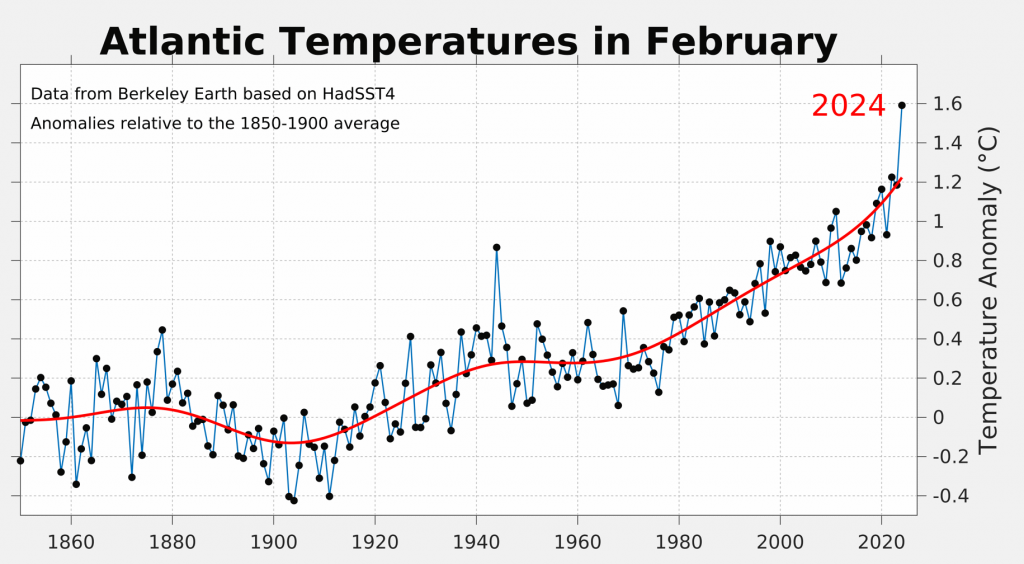
The combination of global warming and El Niño are the primary factors responsible for the present high global average temperature. However, other factors may also be playing a minor role. In particular, the evolution of oceanic heatwaves in the North Atlantic and other areas is likely to play a large role in determining the outlook for 2024.
El Niño Outlook
February 2024 saw a significant weakening of the current El Niño event. The current CPC/IRI analysis suggests that El Niño conditions will dissipate around Northern Hemisphere Summer in 2024. The current El Niño has been categorized as strong — roughly the 3rd strongest of the last 30 years — and it is likely that the current event has already peaked.
The current El Niño is likely to moderately boost global average temperatures during 2024. Due to the lag between the development of El Niño and its full impact being felt on global temperatures, it is plausible that the current El Niño will have a greater impact on global temperatures in 2024 than it did in 2023. If a La Niña event develops in late 2024, as now appears likely, this will generate moderately cooler conditions late in 2024. The interplay between the current El Niño, the possibility of a late 2024 La Niña, and unusual conditions in other regions (e.g. warmth in the North Atlantic) will contribute to whether 2024 is or is not ultimately warmer than 2023.
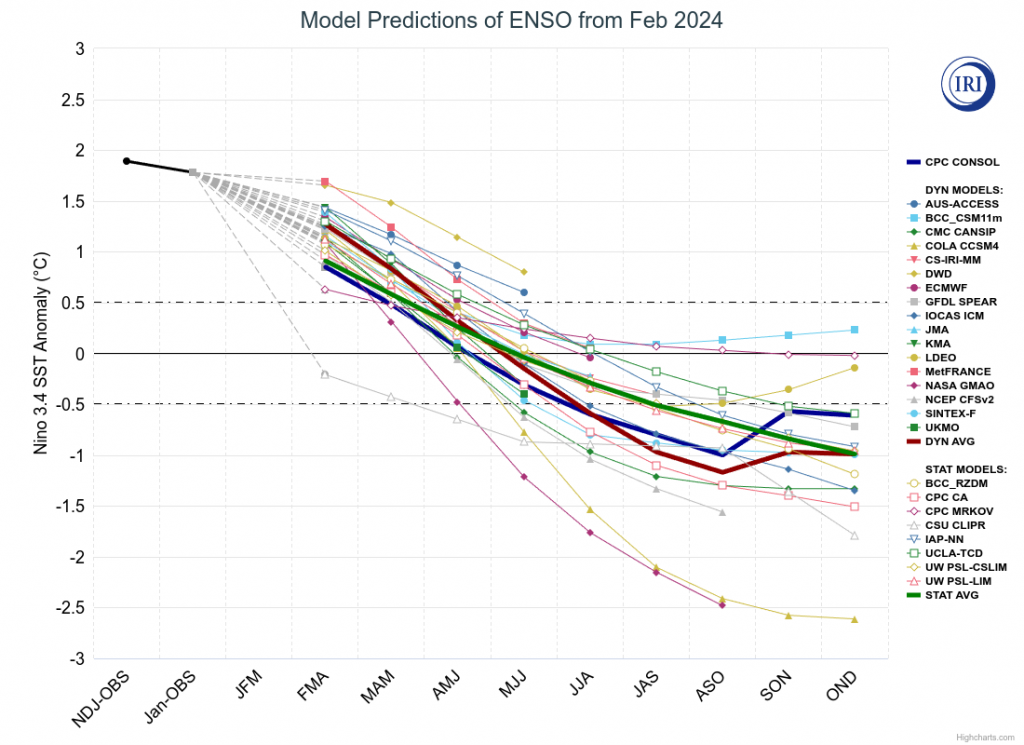
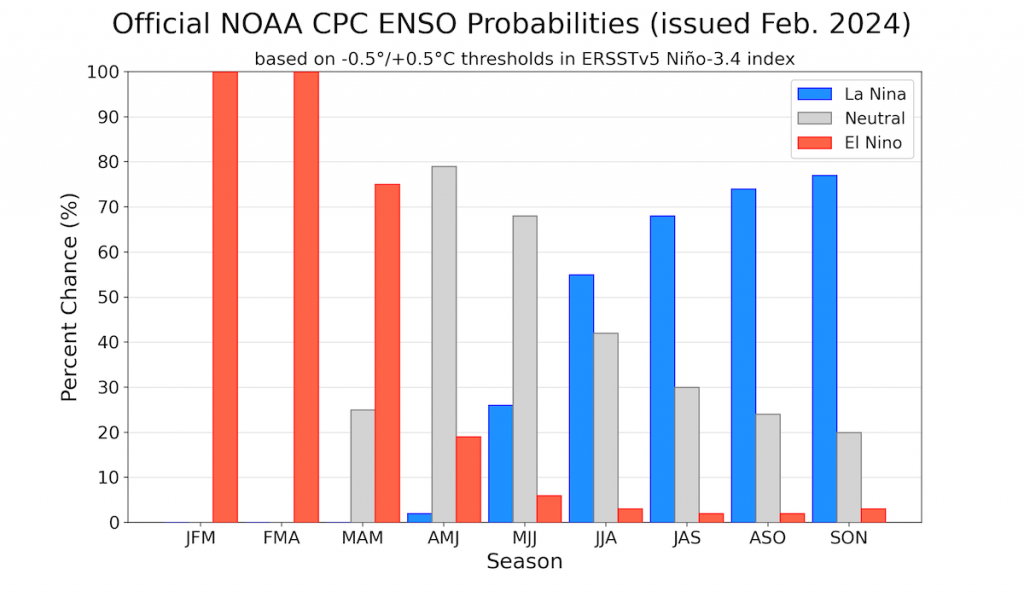
Rest of 2024
2024 will very likely be one of the two warmest years since instrumental measurements began. Whether it is the warmest year on record will depend on whether it can maintain its current warmth long enough to exceed the record annual average set in 2023. It is typically true that the second year after an El Niño emerges is warmer than the first, though that is not guaranteed.
The first two months of 2024 started with very large anomalies, though this is expected to cool somewhat during the latter part of 2024.
The statistical approach that we use, looking at conditions in recent months, now believes that 2024 has a 62% chance of being warmer than 2023, slightly better than a coin flip. The ultimate outcome will depend on the evolution of the current El Niño, the possible switch to La Niña late in 2024, and variation in other regions. However, it is very unlikely that 2024 will be any colder than the second warmest year overall.
Estimated Probability of 2024 Annual Average final rankings:
- 1st – 62%
- 2nd – 37%
- 3rd or lower – 1%
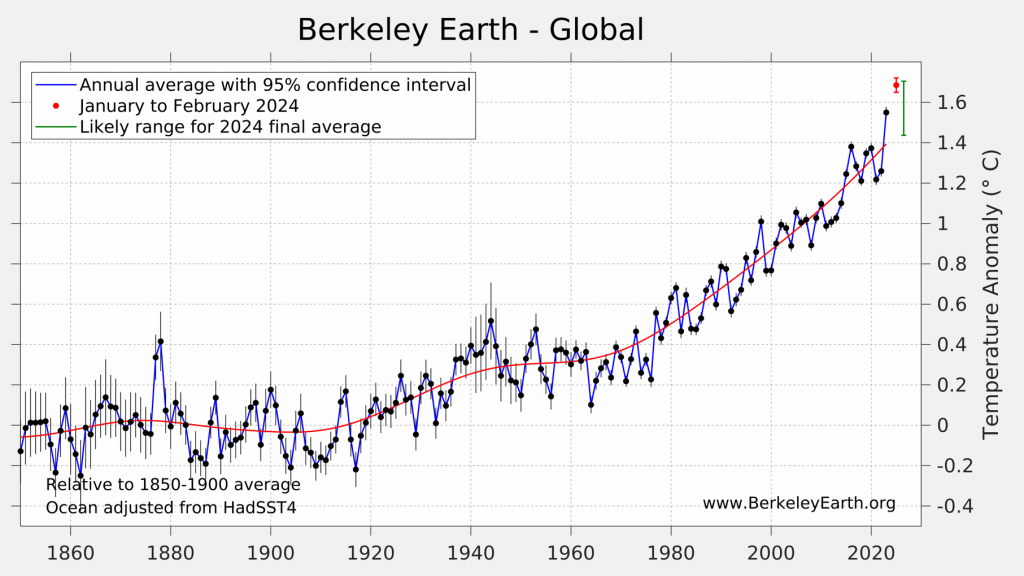
This forecast probability is largely unchanged from the 60% chance estimated last month.
We also consider there to be a 75% chance that 2024 will have an annual-average temperature anomaly more than 1.5 °C (2.7 °F) above our 1850-1900 average. The annual average in 2023 slightly exceeded the 1.5 °C (2.7 °F) threshold in our dataset, and this is likely to occur again in 2024.
Though the IPCC has set a goal to limit global warming to no more than 1.5 °C above the pre-industrial, it must be noted that this goal refers to the long-term average temperature. A few months, or a couple years, warmer than 1.5 °C does not automatically mean that the goal has been exceeded. However, breaching 1.5 °C does serve to emphasize how little time remains to meet this target. Unless sharp reductions in man-made greenhouse gas emissions occur soon, the long-term average is likely to pass 1.5 °C during the 2030s.



